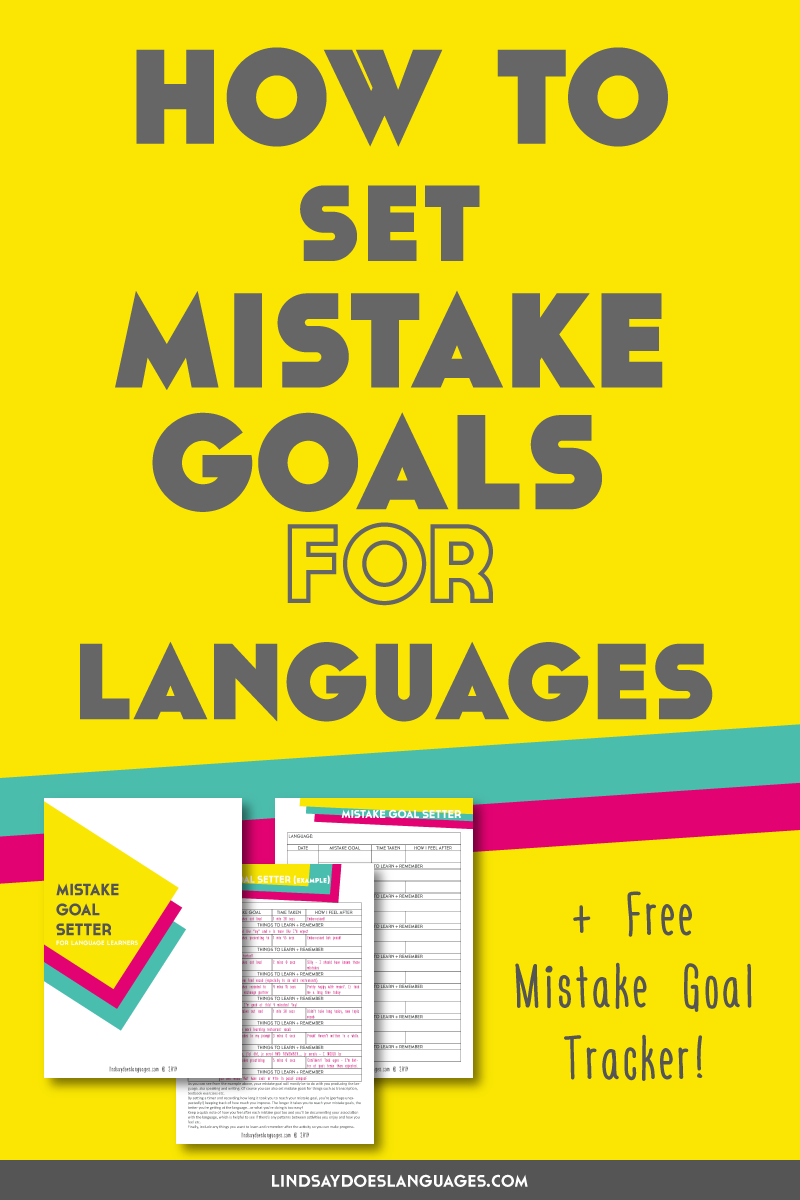May 4th, 2020
How to Set Mistake Goals for Language Learning
Ahh, mistakes! The things that stop us from speaking that language when we really should be giving it all we’ve got. Those things that cripple us with anxiety, fear, and shame when we realise we’ve made one. These things that we’re taught from an early age are bad and deserving of a big red cross. Bad news: you’ve been lied to your whole life about mistakes. Good news: they’re not evil. In fact, they’re actually potentially the most necessary and helpful part of learning a language you could ask for. Here’s how to set mistake goals for language learning.

Many of us actively try and avoid making mistakes, sometimes leading to avoiding speaking, writing or producing the language in any form whatsoever. This is a shame, because mistakes are one of the most powerful tools we have at our disposal as language learners. Make them.
Of course, that alone isn’t enough. If I leave this article there: “Make them”, you probably won’t be convinced and even if you are we’ve not quite dug into the ‘how’ just yet. So stick with me. Here’s why mistakes matter.
You don’t remember every mistake you make. Sometimes you might not even realise you’re making them, but the ones that you do notice, that are pointed out to you, these are what you remember. The things that shape your next attempt at pronouncing the word, conjugating that verb, or figuring out that word order. The things that trigger a memory along the lines of “Oh! This again! I remember the last time when everyone laughed and told me I actually swore instead of asked for the salt and pepper. Now I know what to do…”
But how do you make more of them and not feel like an idiot? We’ve been taught to avoid them.
But they’re only going to make us better. So instead, aim for them. Set yourself mistake goals.
Not only does this mean that you’ll be actively reaching to make mistakes to achieve your goals (because that is quite literally the goal here), but you’re also reframing the idea that mistakes are a bad thing to be avoided.
Once we begin to reframe the concept of mistakes and see them as positive, we want to make more of them, we see their benefit, and we can actually begin to find joy in the imperfection of our current language skills. Hooray!
How to Set Mistake Goals for Language Learning
STEP 1: Prepare to Produce
And no, I’m not asking you to roll up your sleeves and start a jam production line. I’m talking about producing the language. In other words, writing and speaking.
Many language learners focus attention on speaking, which is great, but don’t neglect writing if it’s a full-rounded fluency you’re after.
Each of the key four skills of language (reading, listening, speaking, and writing) have an impact on the others. Sometimes it’s direct and obvious. For example, reading more will of course make you better at writing. Other times however, it may be a little more indirect.
Consider this: writing is a permanent and slow task. That means that when we write stuff, it takes longer than when we speak and it last longer too.
By contrast, speaking is temporary and quick. The speed required to speak “well” is one of the main reasons why we hesitate to speak, and often feel more conscious to avoid mistakes.
So what should I do?
So the first step of preparing to set mistake goals for language learning is preparing ourselves to produce more – be it speaking or writing.
This involves eliminating other elements of fear and anxiety surrounding producing language, so we can focus on making as many mistakes as possible.
For example, we’re not going to be doing this exercise in a conversation setting (you could down the line if you really want to, but not to begin with at least). Therefore, we’re eliminating the fear of making mistakes in front of others and allowing ourselves more space to practise.
With writing, the opposite is true. It tends to be the permanence of writing that puts us off when we’re feeling mistake prone. So what can we do to eliminate this?
Well, firstly, consider if you really really want to eliminate the permanence of writing. Writing with mistake goals in mind can be a great way to document your progress, something that’s beneficial in the long run.
If you decide you’re not worried about that, then consider investing in a whiteboard, a reusable notebook, or a chalkboard. Even typing allows you to delete your writing easier than pen and paper. That way, you can simply erase your writing once you’re done and have checked the mistakes. The permanence is no longer a fear factor slowing you down. Woop!
READ MORE: How to Overcome Shyness When Speaking a Foreign Language
STEP 2: Choose Your How
When setting a mistake goal, you may opt for a longer-term goal such as “make 100 speaking mistakes in a week”, but the longer goals can be harder to track.
Instead, I prefer to make mistake goals into a shorter, controlled activity.
To give you an idea of why, I started experimenting with mistake goals back when Snapchat was more of a thing.
The short video format worked well as a way to record myself speaking, watch it back quickly and check for mistakes, share it, then keep repeating the process until I hit the mistake goal which I would draw as a tally on the videos.
It also helps with any potential fear of making mistakes publicly knowing that the videos only last for 24 hours.
Thankfully, I saved one as an example all those years ago! Here’s a video example of what I’m talking about:
So what should I do?
But you don’t need to use Snapchat to do this. You could use Instagram Stories, record the video directly into your phone, or use a webcam on a laptop.
If you’re feeling nervous about that seeming more permanent, don’t be. Remember, if you don’t want to use mistake goals to document your learning, you’re in control of these files and can totally delete them when you’re done.
And remember, if you’re writing, you’ve got the options we mentioned above of a whiteboard, a reusable notebook, a chalkboard, or typing.
So your second step here is deciding how you’ll track your mistake goals.
Don’t overcomplicate it. Pick one method and run with it.
READ MORE: How to Start Speaking a New Language For The First Time
STEP 3: Set Your Mistake Goal
This is it! We’re here already!
Now you’re ready to go and you know how you’ll be doing it, it’s time to decide what you’re aiming for.
If it’s your first time setting a mistake goal, focus on a small goal, like ‘making 5 mistakes’.
Then, speak or write until you spot 5 mistakes you’ve made.
That’s it. It’s that simple.
Use prompts or things you’ve already read or listened to for inspiration for what to speak or write.
However, if it’s not your first rodeo and you’re ready to take it up a level, you can experiment with more specific mistake goals.
Let’s say you’re quite competent at speaking French but you always fluster over reflexive verbs. A good mistake goal here would be to ‘make 5 reflexive verb conjugation mistakes’.
Now you’ll be speaking and consciously aware of reflexive verbs. This awareness tends to have one of two effects.
One: You’re conscious of when a reflexive verb is coming up and actually find yourself correcting potential mistakes before they’re made. This results in you speaking more and more and more until 5 mistakes are made. Win!
Two: You’re attempting to conjugate those reflexive verbs but are struggling to do it at all, let alone make a mistake when doing it! This results in you being aware that this is a gap in your knowledge, and allows you to go back and actively relearn this topic. Still a win because you’re improving a weak spot.
READ MORE: How to Set Smart Goals for Language Learning
STEP 4: Checking Mistakes
Here’s the bit that people get sceptical about whenever I talk about mistake goals.
“But I don’t know every mistake I’m making! That’s why I’m still making those mistakes!”
I get it.
Setting mistake goals isn’t about knowing every mistake and instantly being able to identify and rectify it.
Remember that Snapchat example I shared earlier? Yeah, there was plenty of time in between hitting record when I’d be checking back to my notes and identifying the mistakes. It wasn’t always instant. That’s why recording in some way works here, because it gives you a chance to re-listen/re-read and see if you can spot your mistakes.
But, of course, there’ll be some mistakes you don’t spot. There’s two options here.
Option One: Leave it. Accept that we’re flawed beings who’ll never be quite perfect and will always make the odd mistake here and there. Let yourself accept that same belief for your language learning.
Option Two: Share it. It could be with a teacher or a language exchange partner, or even just shared publicly on social media. Sharing with native speakers (or people who speak at a higher level than you) can be the key to getting all of those mistakes identified and rectified, including the ones you missed yourself.
READ MORE: How to Get the Most from Your Online Language Lessons with a Tutor
STEP 5: Repeat
Setting mistake goals shouldn’t just be a one time thing if you want it to be effective.
Much like you won’t get 6 pack abs from doing that YouTube video once, you won’t reap the benefits of mistake goals unless it becomes a regular feature of your language learning.
Make mistake goals a part of your routine and you’ll not only be giving yourself more chances to speak and write, but also more chances to improve. Woop!







